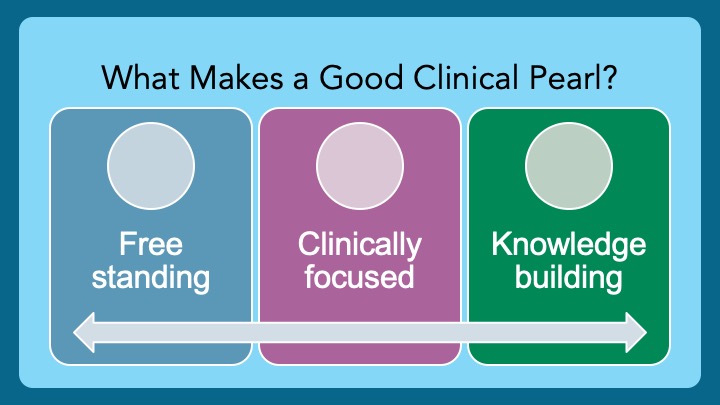1/ Happy Tweetorial Tuesday from @ChrisDJacksonMD!
Clinical pearls? Evidence based medicine? Are we trying to mix oil and water?
Don't worry, your #MedEdTwagTeam crew is here to help with this week's thread!
Clinical pearls? Evidence based medicine? Are we trying to mix oil and water?
Don't worry, your #MedEdTwagTeam crew is here to help with this week's thread!

2/ The clinical pearl bridges our learner's clinical observations and their developing evidence-based practice.
Our learners are often navigating so much clinical data that a well-timed and well-crafted pearl can help them navigate challenging dx & mgmt scenarios
Our learners are often navigating so much clinical data that a well-timed and well-crafted pearl can help them navigate challenging dx & mgmt scenarios

3/ Clinical pearls have 3 important qualities.
They convey a key easily understood clinical point. This information could inform dx, mgmt, or both. Most important, they should build the knowledge of the receiver, pointing out what is not already known.
They convey a key easily understood clinical point. This information could inform dx, mgmt, or both. Most important, they should build the knowledge of the receiver, pointing out what is not already known.

4/ The teaching of clinical pearls is not perfect
Presenting teaching points with qualifiers of ALWAYS or NEVER can misrepresent the reality of clinical practice. Some pearls don't withstand scientific rigor. Lastly, pearls with no clear point can confuse learners.
Presenting teaching points with qualifiers of ALWAYS or NEVER can misrepresent the reality of clinical practice. Some pearls don't withstand scientific rigor. Lastly, pearls with no clear point can confuse learners.

5/ How do we reclaim the pithiness of the clinical pearl while keeping it scientifically sound and effective in teaching future generations of clinicians?
6/ Listed below are some of the clinical pearls repeated multiple times throughout my training. Over the next few slides, I'll share a framework and illustrate how to be more thoughtful in how we discuss pearls on rounds. 

8/ Prime your learners to use pearls with caution. Pearls should be used in specific contexts and they do not replace your clinical judgment. Much like a stethoscope, a clinical pearl is only as useful as the clinician applying it to a patient scenario. 

9/ Context is everything. For each of the pearls above, they do have merit in specific clinical situations. Providing learners the appropriate context for the pearl allows them to incorporate these observations in their developing illness and management scripts for diagnoses. 

10/ After giving the pearl, it's important to have the learner operationalize its meaning. Most pearls have both a dx and tx implication. More important than the pearl is the learner's understanding of how it impacts the patient scenario in question. 

11/ Pearls are not eternal. I encourage and model confirming pearls in real-time. This confirmation can be searching MKSAP, UpToDate, or ACP Journal Club based on the nature of the pearl. I have the learner do it with me, or I ask them to search and report back the next day. 

12/ Your clinical pearls need to serve a purpose to have the most impact. As I listen to a learner present a case, I try to think of the 3 questions below when I formulate a pearl. Grounding the pearl in one of these questions is the hook to engage your learner about a point. 

13/ Please join us next week as @JenniferSpicer4 introduces teaching clinical reasoning.
You can find our previous threads by following @MedEdTwagTeam
You can find our previous threads by following @MedEdTwagTeam

• • •
Missing some Tweet in this thread? You can try to
force a refresh
















